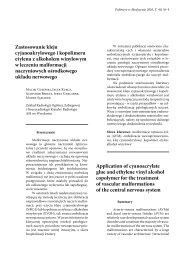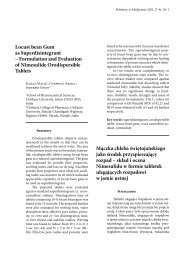52 Witold Musiał i inniRyc. 2. Wpływ kwasu solnego i PA na odczyn wodnegoroztworu zasady lidokainy (po lewej). Zacienionaczęść wykresu odzwierciedla obszar znacznieograniczonej rozpuszczalności lidokainy. Histogramw prawym górnym rogu wskazuje punkt zobojętnienia.Wpływ stężenia na odczyn roztworuPA i LD-HCl (po prawej) – szczegóły w tekścieFig. 2. The influence of HCl aq , and PA on the pH oflidocaine base (left panel). The shadowed part of thediagram represents the area of highly limited solubilityof lidocaine. The histogram on the right-aboveindicates the equimolar point, where the salt of totallidocaine in system with respective acid is observed.The influence of concentration on observed pH ofsolutions of PA and LD-HCl (right panel) – details inthe textzaadaptowane w celu wyznaczenia przybliżonej wartościodczynu mieszaniny lidokainy i polimeru anionowego.Przewidywane na podstawie obliczeń wartościpH lidokainy z dodatkiem kwasu solnego i kwasupoliakrylowego zostały przedstawione na rycinie 2 –po lewej stronie. W warunkach odpowiadającycheksperymentalnym pH roztworu zawierającego równomoloweilości lidokainy i HCl wynosi ok.5,03, i wzrasta do 2,30, po zakwaszeniu roztworudwukrotną ilością HCl. Natomiast w przypadku zastosowaniakwasu poliakrylowego wartość równoważnikowapH wynosi ok. 6,95, co jest wartościącharakterystyczną dla soli słabych kwasów i słabychzasad. Po dodaniu kolejnych porcji kwasu poliakrylowegodo osiągnięcia dwukrotnej ilości tego kwasuw porównaniu z punktem równoważnikowym, pHdochodzi do wartości ok. 6,0. Odpowiednie wartościdla kompartmentu akceptorowego, kiedy dochodzido znacznego rozcieńczenia substancji w przebiegubadania uwalniania przedstawiono na rycinie 3 – poprawej stronie. pH w przypadku rozcieńczania kompleksuLD-PA winno wzrosnąć z ok. 4,25 do ok. 4,76,podczas gdy dla soli LD-HCl wartości te wzrastają od4,95 do 6,20.Przygotowane formulacje z chlorowodorkiemlidokainy ogrzewano, a ich odczyn był odczytywanydla trzech punktów wzrastającej temperatury. Pomiarówdokonywano przed i po zakończeniu procesudializy przez błonę półprzepuszczalną, pomiędzykompartmentem donorowym i akceptorowym. Początkowewartości pH oznaczano jako „ini”, a końcowe,po 24 godzinach procesu, jako „fin” na wykresiena rycinie 3. W przypadku systemu zawierającego lidokainęi kwas poliakrylowy, pH w kompartmenciedonorowym wzrastało nieznacznie w przebiegu dyfuzjileku pomiędzy kompartmentami – rycina3, a różnica pomiędzy odczynem na początku i pozakończeniu badania wynosiła ok. 0,75 jednostki pH.Przeciwnie, w przypadku formulacji zawierającej lidokainęi metylocelulozę pH wzrastało o ok. 2 jednostki,osiągając poziom ok. 6,25. Temperatura miałaniewielki wpływ na wartości pH.Odczyn obserwowany w kompartmencie donorowymw przebiegu pomiarów wzrastał, kiedy substancjaczynna była uwalniana z hydrożelu. Jak towynika z obserwacji mikroskopowej preparatów PA-LD dochodziło w nich do powstawania mikroprecypitatów,co może potwierdzać wpływ kwasowegochlorowodorku lidokainy, o pH pomiędzy 4,0-5,5, nadysocjację kwasu poliakrylowego. Zgodnie z wytworzonąw preparacie równowagą, kwas poliakrylowywytrącał się, a otrzymane mieszaniny charakteryzofromthe hydrogel. In microscopic observation of PA-LD preparations the micro-sedimentation was revealed,which confirms the influence of acidic lidocainehydrochloride, of pH between 4,0–5,5 on disso-
<strong>Polimery</strong>Ryc. 3. Zmiany pH w kompartmencie donorowym(po lewej), oraz w kompartmencie akceptorowym(po prawej) – szczegóły w tekścieFig. 3. The pH changes in the donor (left panel), andacceptor (right panel) compartment - details in thetextwały się opalescencją, co wskazuje na równomiernerozproszenie osadu w systemie wodnym – rycina 4.Fakt ten umożliwia zastosowanie tych systemówna skórze w formie maści, kremów lub żeli. Otrzymanakompozycja umożliwia przedłużone utrzymanieniskiego odczynu na powierzchni skóry. Według53ciation of polyacrylic acid. According to theequi libriums, the polyacrylic acid sedimented, howeverobtained mixture was opalescent rather, and homogenouslydispersed in aqueous environment – Figure4.This enables the application of the system onskin in the form of an ointment, cream, or gel. Thecomposition enables prolonged maintaining of lowpH on the skin. According to our data from formerrelease experiment, the pH was maintained on thelevel not higher then 4,0 in the period of 12 hours,whereas in the case of preparation with methylcellulose,the pH increased from acceptable pH of ca. 4,5to the level of above 6,0 [18]. The application of polyacrylicacid as the vehicle for the preparation appliedon the skin should give better clinical answer, comparingto the preparation with methylcellulose. Additionalfeature would be the prolongation of thedrug release due to the formation of microprecipitate.On the Figure 5, there are microphotographs of preparationsof lidocaine hydrochloride with polyacrylicacid (left ), and with methylcellulose (right).Also in the acceptor compartment the pH alteredwith time, when release of the drug occurred. The startingvalue of the acceptor compartment was assessed asca. 5,5 pH. With time, and increasing amount of lidocainein the compartment, the opposite tendencies wereobserved in the systems with methylcellulose and polyacrylicacid. In the acceptor compartment relative toPA-LD system the pH decreased, as expected, accordingto the increase of concentration of hydrochloride salt oflidocaine in the acceptor compartment.Considering the release of total amount of lidocainehydrochloride to the acceptor compartment,the concentration would be in the range of 0,015mol/l, what reflects the pH of ca. 5,0 for the salt oflidocaine and hydrochloric acid, and pH ca. 7,0 forMC-LD-22MC-LD-32MC-LD-41Ryc. 4. Obrazy próbek ogrzewanychw warunkach odpowiadającychwarunkom eksperymentu,tj. w temp. 22°C, 32°C i 41°C– w badanym zakresie stężeńnie zaobserwowano osaduPA-LD-22PA-LD-32PA-LD-41Fig. 4. Images of samples heatedin the conditions reflecting theexperiment, i. e. at 22°C, 32°Cand 41°C – in respective temperaturesno sedimentation wasobserved
















